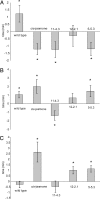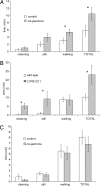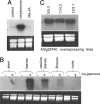cis-Jasmone induces Arabidopsis genes that affect the chemical ecology of multitrophic interactions with aphids and their parasitoids
- PMID: 18356298
- PMCID: PMC2290791
- DOI: 10.1073/pnas.0710305105
cis-Jasmone induces Arabidopsis genes that affect the chemical ecology of multitrophic interactions with aphids and their parasitoids
Abstract
It is of adaptive value for a plant to prepare its defenses when a threat is detected, and certain plant volatiles associated with insect damage, such as cis-jasmone (CJ), are known to switch-on defense metabolism. We used aphid and aphid parasitoid responses to Arabidopsis thaliana as a model system for studying gene expression and defense chemistry and its impact at different trophic levels. Differential responses to volatiles of induced Arabidopsis occurred for specialist and generalist insects: the generalist aphid, Myzus persicae, was repelled, whereas the specialist, Lipaphis erysimi, was attracted; the generalist aphid parasitoid Aphidius ervi was attracted, but the specialist parasitoid Diaeretiella rapae was not affected. A. ervi also spent longer foraging on induced plants than on untreated ones. Transcriptomic analyses of CJ-induced Arabidopsis plants revealed that a limited number of genes, including a gene for a cytochrome P450, CYP81D11, were strongly up-regulated in the treated plants. We examined transgenic Arabidopsis lines constitutively overexpressing this gene in bioassays and found insect responses similar to those obtained for wild-type plants induced with CJ, indicating the importance of this gene in the CJ-activated defense response. Genes involved in glucosinolate biosynthesis and catabolism are unaffected by CJ and, because these genes relate to interactions with herbivores and parasitoids specific to this family of plants (Brassicaceae), this finding may explain the differences in behavioral response of specialist and generalist insects.
Conflict of interest statement
The authors declare no conflict of interest.
Figures




References
-
- Karban R, Kuc J. Induced resistance against pathogens and herbivores: An overview. In: Agrawal AA, Tuzun S, Bent E, editors. Induced Plant Defence Against Pathogens and Herbivores. APS Press: St. Paul, MN; 1999. pp. 1–16.
-
- Chamberlain K, Pickett JA, Woodcock CM. Plant signalling and induced defence in insect attack. Mol Plant Pathol. 2000;1:67–72. - PubMed
-
- Alborn HT, et al. An elicitor of plant volatiles from beet armyworm oral secretion. Science. 1997;276:945–949.
-
- Karban R, Baldwin IT, Baxter KJ, Laue G, Felton GW. Communication between plants: Induced resistance in wild tobacco plants following clipping of neighboring sagebrush. Oecologia. 2000;125:66–71. - PubMed
Publication types
MeSH terms
Substances
Grants and funding
LinkOut - more resources
Full Text Sources
Molecular Biology Databases
Research Materials

